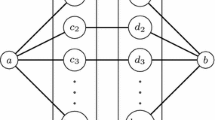Abstract
Several recent papers have shown that some properties of the maximum weight stable set problem hold true in the more general setting of binary integer programs with two variables per inequality. In this paper, we show that in fact the two problems are equivalent by using the transitive closure of the binary integer program and (possibly) reducing the number of variables by fixing, complementing, or identifying them. We use this equivalence to prove two conjectures made by Johnson and Padberg regarding the perfection of bidirected graphs.
Similar content being viewed by others
References
J.M. Bourjolly, Integral and Fractional Node-Packings, and Pseudo-Boolean Programming, Ph.D. Thesis, University of Waterloo, Waterloo, Ontario (1986).
J.M. Bourjolly, An extension of the König-Egerváry property to node-weighted bidirected graphs.Mathematical Programming 41 (1988) 375–384.
H. Crowder, E.L. Johnson and M. Padberg, Solving large-scale zero-one linear programming problems,Operations Research 31 (5) (1983) 803–834.
M. Guignard and K. Spielberg, Logical reduction methods in zero-one programming. Minimal preferred variables,Operations Research 29 (1) (1981) 49–74.
P.L. Hammer and S. Nguyen. A partial order in the solution space of bivalent programs, in: N. Christofides et al., eds.,Combinatorial Optimization (John Wiley and Sons, New York, 1979) 93–106.
P. Hansen, A cascade algorithm for the logical closure of a set of binary relations,Information Processing Letters 5 (2) (1976) 50–54.
P. Hansen, B. Jaumard and M. Minoux, A linear expected-time algorithm for deriving all logical conclusions implied by a set of boolean inequalities.Mathematical Programming 34 (1986) 223–231.
D.S. Hochbaum, N. Megiddo, J. Naor and A. Tamir, Tight bounds and 2-approximation algorithms for integer programs with two variables per inequality, Technical report. University of California, Berkeley, CA (1992).
K.L. Hoffman and M. Padberg, Improving LP-representations of zero-one linear programs for branchand-cut,ORSA Journal on Computing 3 (2) (1991) 121–134.
E.L. Johnson and M.W. Padberg, Degree-two inequalities, clique facets, and biperfect graphs,Annals of Discrete Mathematics 16 (1982) 169–187.
G.L. Nemhauser and L.E. Trotter Jr., Vertex packings: Structural properties and algorithms,Mathematical Programming 8 (1975) 232–248.
A. Tucker, Critical perfect graphs and perfect 3-chromatic graphs,Journal of Combinatorial Theory (Series B) 23 (1977) 143–149.
Author information
Authors and Affiliations
Rights and permissions
About this article
Cite this article
Sewell, E.C. Binary integer programs with two variables per inequality. Mathematical Programming 75, 467–476 (1996). https://doi.org/10.1007/BF02592194
Received:
Revised:
Issue Date:
DOI: https://doi.org/10.1007/BF02592194




